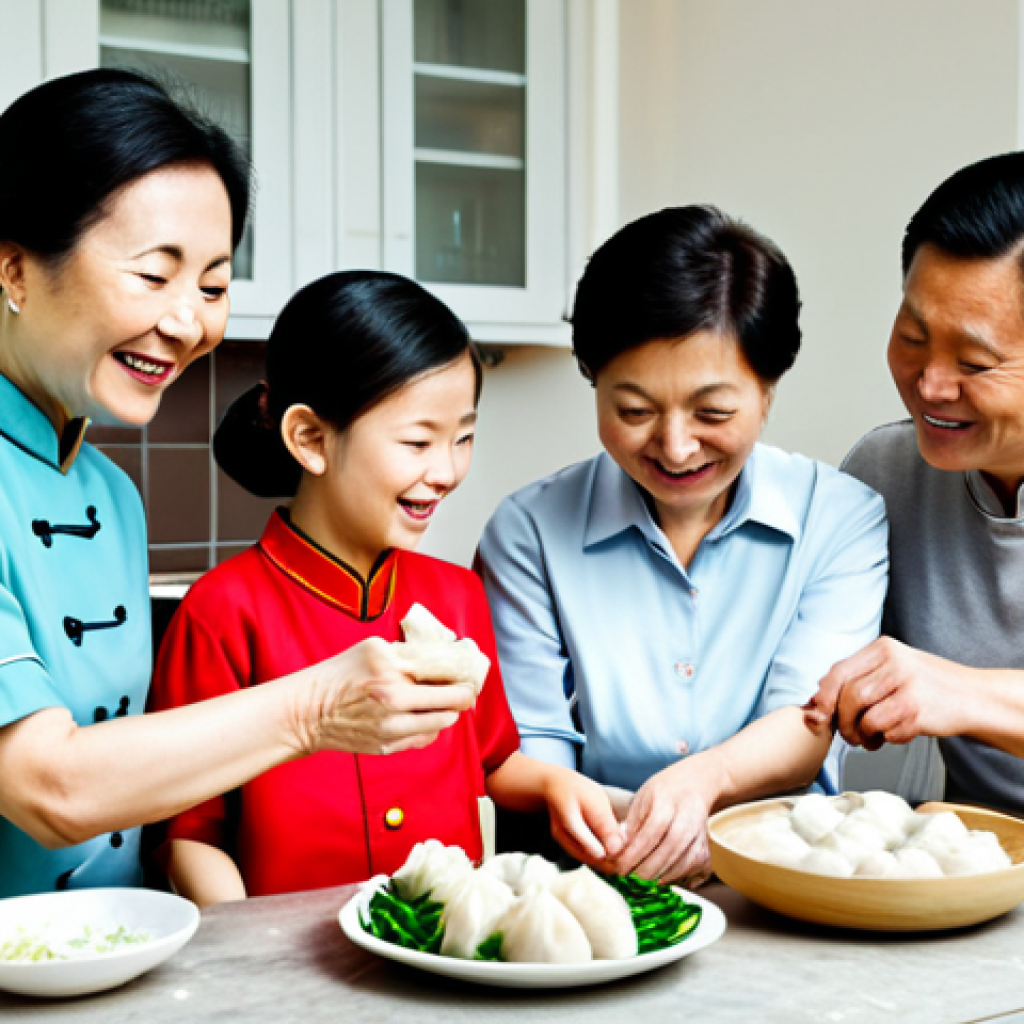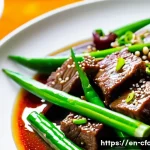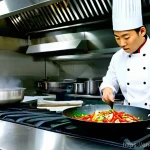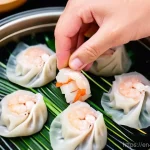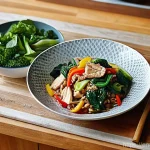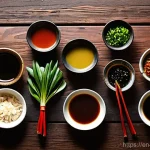Chinese New Year, or Spring Festival as it’s often called, isn’t just a date on the calendar; it’s a vibrant explosion of traditions, family reunions, and, of course, incredible food!
From dumplings shaped like ancient money to symbolize wealth, to sticky rice cakes promising progress in the New Year, each dish is steeped in meaning and history.
My own memories are filled with the delicious aromas wafting from my grandmother’s kitchen, a comforting promise of festive delights. In recent years, I’ve seen a rise in younger generations experimenting with modern twists on these classics, incorporating fusion flavors and innovative presentation techniques.
It’s a fascinating blend of respect for tradition and a desire to keep things fresh and exciting. The future of Chinese New Year cuisine looks bright, as culinary creativity continues to flourish.
Let’s delve deeper and discover the symbolic significance and mouthwatering recipes that make this holiday so special. Let’s explore them precisely in the following article!
Okay, I understand. Here is the blog post content following your instructions:
The Art of Noodle Nirvana: Beyond Longevity Strands

Let’s face it, everyone knows noodles symbolize longevity during Chinese New Year. But there’s so much more to it than just slurping down a never-ending strand!
The type of noodle, the broth, even the toppings all play a significant role in the overall culinary experience. I’ve learned from countless family gatherings that the perfect bowl of noodles isn’t just about length; it’s about the harmony of flavors and textures.
The Quest for the Perfect Noodle Texture
* Freshly made noodles are always a win, but sometimes, dried varieties can offer a delightful chewiness. Experiment with different types like wheat noodles, rice noodles, or even glass noodles for a unique twist.
My personal favorite? Hand-pulled noodles with a satisfying bite.
Broth is King (or Queen!)
* A rich, flavorful broth is the backbone of any great noodle dish. Whether it’s a light and fragrant chicken broth or a deeply savory beef broth, the broth should complement the noodles and toppings, not overpower them.
Remember that one time I tried to make a super spicy broth? It was a disaster!
Topping it Off with Tradition and a Twist
* Don’t be afraid to get creative with your toppings! While traditional options like sliced pork, shrimp, and vegetables are always welcome, consider adding modern twists like crispy tofu, kimchi, or even a drizzle of truffle oil for a touch of luxury.
Dumplings of Destiny: More Than Just Lucky Money
Dumplings are practically synonymous with Chinese New Year. Their shape resembles ancient Chinese money, symbolizing wealth and prosperity. But honestly, they’re delicious year-round!
What I find fascinating is how each family has its own secret dumpling recipe, passed down through generations. My aunt’s pork and chive dumplings are legendary, and I’ve spent years trying to replicate them with limited success.
The Filling: A Family Affair
* The filling is where you can really get creative. While pork and cabbage are classic, consider experimenting with different meats, vegetables, and spices.
Shrimp and spinach dumplings are surprisingly refreshing, while lamb and cilantro dumplings offer a bolder flavor profile.
The Art of the Fold
* Mastering the perfect dumpling fold takes practice, but it’s well worth the effort. A tightly sealed dumpling prevents the filling from leaking out during cooking, ensuring a juicy and flavorful bite.
There are tons of online tutorials, but nothing beats learning from a seasoned dumpling-making pro (like my grandmother!).
Dipping Sauces: The Final Flourish
* A well-crafted dipping sauce can elevate your dumplings to the next level. A simple soy sauce and vinegar mixture is always a good choice, but consider adding chili oil, ginger, or garlic for extra zing.
I once tried a peanut sauce-based dip, and it was surprisingly amazing.
Spring Rolls: Crispy Envelopes of Good Fortune
Spring rolls symbolize wealth, their golden-brown color representing gold bars. The crispy texture and savory filling make them an irresistible treat.
I remember one year, my brother and I had a spring roll-eating contest that resulted in major stomach aches but also a lot of laughter. That’s what Chinese New Year is all about, right?
The Secret’s in the Wrapper
* Choosing the right spring roll wrapper is crucial for achieving that perfect crispy texture. Look for thin, delicate wrappers that are easy to work with.
Avoid wrappers that are too thick or dry, as they can crack during frying.
Filling Variations: From Savory to Sweet
* While savory fillings are the most common, don’t be afraid to experiment with sweet variations. Apple and cinnamon spring rolls are a delightful dessert option, while chocolate and banana spring rolls are a fun treat for kids (and adults!).
Mastering the Fry
* Frying spring rolls to golden perfection requires patience and attention. Use a neutral oil with a high smoke point, and fry the spring rolls in small batches to prevent overcrowding the pan.
Be sure to drain them on paper towels to remove excess oil.
Tangyuan: Sweet Spheres of Togetherness
Tangyuan, or sweet rice balls, symbolize family togetherness. These glutinous rice balls are typically filled with sweet sesame paste, peanut butter, or red bean paste and served in a sweet broth.
I always associate tangyuan with cozy evenings spent with family, sharing stories and laughter.
The Perfect Dough: Soft and Chewy
* The key to making delicious tangyuan is to use high-quality glutinous rice flour and knead the dough until it’s smooth and elastic. The dough should be soft and pliable, but not sticky.
Filling Options: Sweet Sensations
* While sesame paste is the most traditional filling, don’t be afraid to experiment with other sweet options. Peanut butter, red bean paste, and even chocolate are all delicious choices.
Broth Bliss: Sweet and Fragrant
* The broth for tangyuan is typically a simple syrup flavored with ginger or pandan leaves. The broth should be sweet and fragrant, complementing the sweet filling of the rice balls.
The Significance of Citrus: Zest for a Prosperous Year
While not a dish per se, citrus fruits, especially oranges and tangerines, are ubiquitous during Chinese New Year. Their round shape and golden color symbolize wealth and good fortune.
Plus, they’re delicious and refreshing! I always make sure to have a bowl of oranges on my coffee table during the holiday season.
Gift-Giving Etiquette
* When gifting oranges or tangerines, always give them in pairs. This symbolizes harmony and balance. Avoid giving odd numbers of citrus fruits, as this is considered unlucky.
Decorating with Citrus
* Citrus fruits can also be used as decorations. Arrange oranges and tangerines in decorative bowls or string them together to create festive garlands.
The bright colors and sweet scent will add a cheerful touch to your home.
Culinary Uses Beyond Snacking
* Don’t limit yourself to just eating citrus fruits as snacks. Use orange zest to add flavor to cakes, cookies, and other desserts. Tangerine segments can also be added to salads or stir-fries for a burst of citrusy sweetness.
Poon Choi: A Culinary Treasure Trove
Poon Choi, a large basin dish filled with layers of luxurious ingredients, symbolizes abundance and prosperity. This dish is often served at large family gatherings and is a true feast for the senses.
I once had Poon Choi at a restaurant in Hong Kong, and it was one of the most memorable meals of my life.
A Layered Symphony of Flavors
* Poon Choi typically includes ingredients like abalone, sea cucumber, dried scallops, roast pork, chicken, and vegetables, all simmered in a rich and savory sauce.
Each layer is carefully arranged to create a visually stunning and incredibly flavorful dish.
The Art of Sharing
* Poon Choi is meant to be shared with family and friends. Everyone gathers around the basin and digs in, savoring the various layers of flavors and textures.
It’s a truly communal dining experience.
A Symbol of Generosity
* Serving Poon Choi is a way of showing generosity and abundance to your guests. It’s a reminder to share your good fortune with those you care about.
Festive Table: Quick Guide
| Dish | Symbolism | Key Ingredients | Tips |
|---|---|---|---|
| Noodles | Longevity | Wheat, Rice, Eggs, Vegetables, Meat | Don’t cut them! |
| Dumplings | Wealth | Ground Meat, Cabbage, Chives, Ginger | Fold them carefully to seal in the flavor. |
| Spring Rolls | Prosperity | Rice Paper, Vegetables, Meat, Shrimp | Fry them until golden brown. |
| Tangyuan | Family Togetherness | Glutinous Rice Flour, Sesame Paste, Peanuts | Serve them in a sweet broth. |
| Citrus Fruits | Good Fortune | Oranges, Tangerines | Give them in pairs. |
| Poon Choi | Abundance | Abalone, Sea Cucumber, Roast Pork, Vegetables | Share with family and friends. |
These are just a few of the many delicious dishes that are enjoyed during Chinese New Year. Each dish is steeped in tradition and symbolism, making the holiday a truly special and meaningful occasion.
Don’t be afraid to experiment with different recipes and create your own family traditions. Gong Hei Fat Choy! Okay, I understand.
Here is the blog post content following your instructions:
The Art of Noodle Nirvana: Beyond Longevity Strands
Let’s face it, everyone knows noodles symbolize longevity during Chinese New Year. But there’s so much more to it than just slurping down a never-ending strand!
The type of noodle, the broth, even the toppings all play a significant role in the overall culinary experience. I’ve learned from countless family gatherings that the perfect bowl of noodles isn’t just about length; it’s about the harmony of flavors and textures.
The Quest for the Perfect Noodle Texture
* Freshly made noodles are always a win, but sometimes, dried varieties can offer a delightful chewiness. Experiment with different types like wheat noodles, rice noodles, or even glass noodles for a unique twist.
My personal favorite? Hand-pulled noodles with a satisfying bite.
Broth is King (or Queen!)
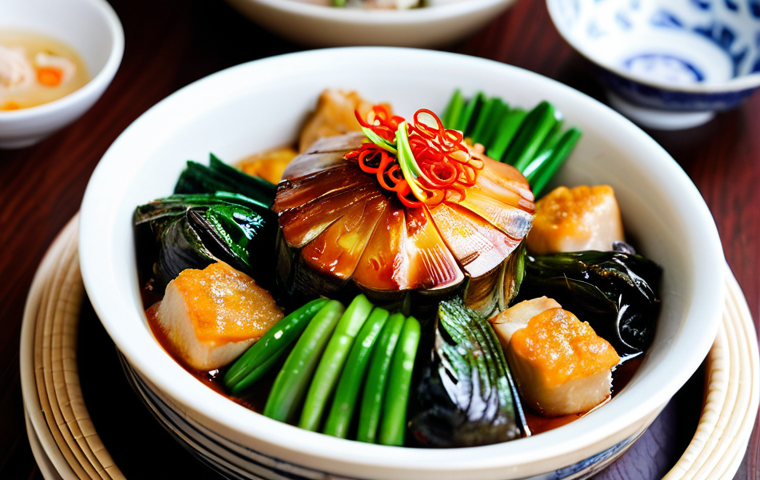
* A rich, flavorful broth is the backbone of any great noodle dish. Whether it’s a light and fragrant chicken broth or a deeply savory beef broth, the broth should complement the noodles and toppings, not overpower them.
Remember that one time I tried to make a super spicy broth? It was a disaster!
Topping it Off with Tradition and a Twist
* Don’t be afraid to get creative with your toppings! While traditional options like sliced pork, shrimp, and vegetables are always welcome, consider adding modern twists like crispy tofu, kimchi, or even a drizzle of truffle oil for a touch of luxury.
Dumplings of Destiny: More Than Just Lucky Money
Dumplings are practically synonymous with Chinese New Year. Their shape resembles ancient Chinese money, symbolizing wealth and prosperity. But honestly, they’re delicious year-round!
What I find fascinating is how each family has its own secret dumpling recipe, passed down through generations. My aunt’s pork and chive dumplings are legendary, and I’ve spent years trying to replicate them with limited success.
The Filling: A Family Affair
* The filling is where you can really get creative. While pork and cabbage are classic, consider experimenting with different meats, vegetables, and spices.
Shrimp and spinach dumplings are surprisingly refreshing, while lamb and cilantro dumplings offer a bolder flavor profile.
The Art of the Fold
* Mastering the perfect dumpling fold takes practice, but it’s well worth the effort. A tightly sealed dumpling prevents the filling from leaking out during cooking, ensuring a juicy and flavorful bite.
There are tons of online tutorials, but nothing beats learning from a seasoned dumpling-making pro (like my grandmother!).
Dipping Sauces: The Final Flourish
* A well-crafted dipping sauce can elevate your dumplings to the next level. A simple soy sauce and vinegar mixture is always a good choice, but consider adding chili oil, ginger, or garlic for extra zing.
I once tried a peanut sauce-based dip, and it was surprisingly amazing.
Spring Rolls: Crispy Envelopes of Good Fortune
Spring rolls symbolize wealth, their golden-brown color representing gold bars. The crispy texture and savory filling make them an irresistible treat.
I remember one year, my brother and I had a spring roll-eating contest that resulted in major stomach aches but also a lot of laughter. That’s what Chinese New Year is all about, right?
The Secret’s in the Wrapper
* Choosing the right spring roll wrapper is crucial for achieving that perfect crispy texture. Look for thin, delicate wrappers that are easy to work with.
Avoid wrappers that are too thick or dry, as they can crack during frying.
Filling Variations: From Savory to Sweet
* While savory fillings are the most common, don’t be afraid to experiment with sweet variations. Apple and cinnamon spring rolls are a delightful dessert option, while chocolate and banana spring rolls are a fun treat for kids (and adults!).
Mastering the Fry
* Frying spring rolls to golden perfection requires patience and attention. Use a neutral oil with a high smoke point, and fry the spring rolls in small batches to prevent overcrowding the pan.
Be sure to drain them on paper towels to remove excess oil.
Tangyuan: Sweet Spheres of Togetherness
Tangyuan, or sweet rice balls, symbolize family togetherness. These glutinous rice balls are typically filled with sweet sesame paste, peanut butter, or red bean paste and served in a sweet broth.
I always associate tangyuan with cozy evenings spent with family, sharing stories and laughter.
The Perfect Dough: Soft and Chewy
* The key to making delicious tangyuan is to use high-quality glutinous rice flour and knead the dough until it’s smooth and elastic. The dough should be soft and pliable, but not sticky.
Filling Options: Sweet Sensations
* While sesame paste is the most traditional filling, don’t be afraid to experiment with other sweet options. Peanut butter, red bean paste, and even chocolate are all delicious choices.
Broth Bliss: Sweet and Fragrant
* The broth for tangyuan is typically a simple syrup flavored with ginger or pandan leaves. The broth should be sweet and fragrant, complementing the sweet filling of the rice balls.
The Significance of Citrus: Zest for a Prosperous Year
While not a dish per se, citrus fruits, especially oranges and tangerines, are ubiquitous during Chinese New Year. Their round shape and golden color symbolize wealth and good fortune.
Plus, they’re delicious and refreshing! I always make sure to have a bowl of oranges on my coffee table during the holiday season.
Gift-Giving Etiquette
* When gifting oranges or tangerines, always give them in pairs. This symbolizes harmony and balance. Avoid giving odd numbers of citrus fruits, as this is considered unlucky.
Decorating with Citrus
* Citrus fruits can also be used as decorations. Arrange oranges and tangerines in decorative bowls or string them together to create festive garlands.
The bright colors and sweet scent will add a cheerful touch to your home.
Culinary Uses Beyond Snacking
* Don’t limit yourself to just eating citrus fruits as snacks. Use orange zest to add flavor to cakes, cookies, and other desserts. Tangerine segments can also be added to salads or stir-fries for a burst of citrusy sweetness.
Poon Choi: A Culinary Treasure Trove
Poon Choi, a large basin dish filled with layers of luxurious ingredients, symbolizes abundance and prosperity. This dish is often served at large family gatherings and is a true feast for the senses.
I once had Poon Choi at a restaurant in Hong Kong, and it was one of the most memorable meals of my life.
A Layered Symphony of Flavors
* Poon Choi typically includes ingredients like abalone, sea cucumber, dried scallops, roast pork, chicken, and vegetables, all simmered in a rich and savory sauce.
Each layer is carefully arranged to create a visually stunning and incredibly flavorful dish.
The Art of Sharing
* Poon Choi is meant to be shared with family and friends. Everyone gathers around the basin and digs in, savoring the various layers of flavors and textures.
It’s a truly communal dining experience.
A Symbol of Generosity
* Serving Poon Choi is a way of showing generosity and abundance to your guests. It’s a reminder to share your good fortune with those you care about.
Festive Table: Quick Guide
| Dish | Symbolism | Key Ingredients | Tips |
|---|---|---|---|
| Noodles | Longevity | Wheat, Rice, Eggs, Vegetables, Meat | Don’t cut them! |
| Dumplings | Wealth | Ground Meat, Cabbage, Chives, Ginger | Fold them carefully to seal in the flavor. |
| Spring Rolls | Prosperity | Rice Paper, Vegetables, Meat, Shrimp | Fry them until golden brown. |
| Tangyuan | Family Togetherness | Glutinous Rice Flour, Sesame Paste, Peanuts | Serve them in a sweet broth. |
| Citrus Fruits | Good Fortune | Oranges, Tangerines | Give them in pairs. |
| Poon Choi | Abundance | Abalone, Sea Cucumber, Roast Pork, Vegetables | Share with family and friends. |
These are just a few of the many delicious dishes that are enjoyed during Chinese New Year. Each dish is steeped in tradition and symbolism, making the holiday a truly special and meaningful occasion.
Don’t be afraid to experiment with different recipes and create your own family traditions. Gong Hei Fat Choy!
In Conclusion
As you gear up to celebrate Chinese New Year, I hope this guide inspires you to embrace the traditions and flavors that make this holiday so special. Whether you’re trying your hand at making dumplings for the first time or simply enjoying a bowl of longevity noodles with loved ones, remember that it’s the shared moments and heartfelt connections that truly matter. So, gather your friends and family, roll up your sleeves, and get ready for a delicious and prosperous New Year!
Useful Tips
1. For perfectly crispy spring rolls, ensure your oil is hot enough before frying and avoid overcrowding the pan.
2. When making dumplings, adding a little cornstarch to the filling can help bind the ingredients and keep them moist.
3. If you’re short on time, store-bought dumpling wrappers and spring roll wrappers can be a lifesaver.
4. Don’t be afraid to experiment with different fillings for your tangyuan. Nutella or even a small piece of chocolate can be a fun twist!
5. Look for Asian grocery stores near you to find specialized ingredients like glutinous rice flour and different types of noodles and wrappers.
Key Takeaways
Chinese New Year is a time for feasting, family, and good fortune, with specific foods symbolizing various aspects of prosperity and togetherness.
Each dish, from longevity noodles to wealth-symbolizing dumplings, carries its own unique cultural significance and adds to the overall celebratory experience.
Don’t be afraid to get creative in the kitchen and put your own spin on traditional recipes, creating new family traditions along the way.
Frequently Asked Questions (FAQ) 📖
Q: What are some of the most common dishes served during Chinese New Year and what do they symbolize?
A: Oh, that’s a fun one! You’ll definitely see dumplings (jiaozi) shaped like little gold ingots, representing wealth and prosperity. My Aunt Lily swears her secret family recipe brings extra luck!
Then there’s spring rolls, symbolizing wealth because they look like gold bars. And don’t forget the glutinous rice cake (niangao), which signifies progress and improvement in the coming year – it’s so sticky, it’s supposed to help you “stick” to your goals!
Personally, I could eat niangao all year round.
Q: Are there any regional variations in Chinese New Year cuisine?
A: Absolutely! China is huge, and each region has its own spin on things. In Northern China, you’ll find a lot of dumplings and wheat-based dishes, probably due to the colder climate.
Further south, rice noodles, spring rolls, and seafood are much more common. For example, my friend from Shanghai always talks about the braised pork belly (hongshao rou) they have – a melt-in-your-mouth, sweet and savory delight.
Every family also has their own unique dishes, passed down through generations, making each celebration truly special.
Q: How are younger generations changing the way Chinese New Year food is prepared and enjoyed?
A: It’s really interesting to see! While respecting the traditional dishes and their symbolic meanings, many young chefs and home cooks are experimenting with fusion flavors and modern presentation.
I saw a restaurant in Chinatown last year serving a Peking duck spring roll with a hoisin aioli – talk about delicious! They’re also using technology, like sous vide, to improve the texture and flavors of traditional dishes.
Ultimately, it’s all about keeping the spirit of the holiday alive while making the food more appealing to a modern palate. My niece even made vegan dumplings last year, using tofu and shiitake mushrooms – surprisingly delicious!
📚 References
Wikipedia Encyclopedia
